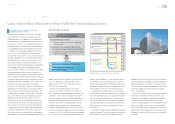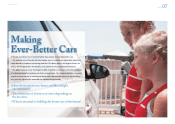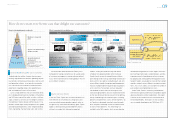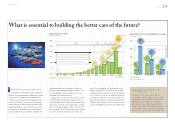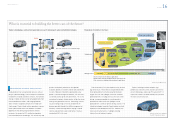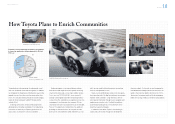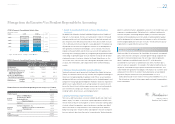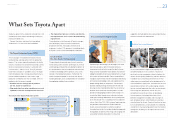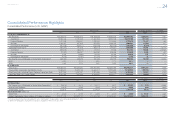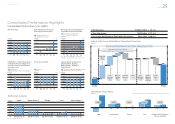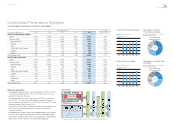Toyota 2013 Annual Report Download - page 16
Download and view the complete annual report
Please find page 16 of the 2013 Toyota annual report below. You can navigate through the pages in the report by either clicking on the pages listed below, or by using the keyword search tool below to find specific information within the annual report.
Source: Toyota Motor Corp.
Toyota Global Vision President’s Message Launching a New Structure Special Feature Review of Operations
Consolidated Performance
Highlights
Management and
Corporate Information Investor InformationFinancial Section
Page 16
NextPrev
ContentsSearchPrint
ANNUAL REPORT 2013
What will be the next winner among eco-cars?
Toyota believes that next-generation eco-cars will use
plug-in hybrid technology, a new concept that combines
the benefi ts of hybrid and electric vehicles. The batteries
of plug-in hybrid vehicles can be recharged directly from
household electrical outlets, and charging batteries
allows vehicles to operate primarily in EV mode over
short ranges. Plug-in hybrid vehicles operate as conven-
tional hybrid vehicles once their batteries have been
depleted. As the driving range of electric vehicles
increases, the amount of CO2 emitted and gasoline
consumed decreases accordingly. This will not only help
Fuel cell vehicles (FCVs) also represent a key technol-
ogy of the future. These vehicles are powered by elec-
tricity generated by the chemical reaction between
oxygen in the air and hydrogen, and have numerous
potential benefi ts, including zero CO2 emissions while
driving, a range comparable to a similar gasoline-
powered car, and the fact that hydrogen can be
produced from a variety of primary energy sources. The
hybrid technologies honed by Toyota to date are vitally
important to the development of FCVs. However, the
necessary infrastructure (i.e., hydrogen refueling
stations) has yet to be put in place.
prevent atmospheric pollution but also provide
economic benefi ts in the form of lower fuel and electric-
ity costs. Moreover, if electricity generated by solar
power is used to recharge car batteries, CO2 emissions
can be reduced to signifi cantly lower levels. This is why
we believe that plug-in hybrid vehicles will be the winner
among next-generation eco-cars. Generating, conserv-
ing, and storing energy at the household level will
become possible through the skillful management of
electricity used to recharge electric or plug-in hybrid
vehicles and electricity used inside homes. Toyota is
conducting R&D in this area.
Toyota is working to create compact, high-
performance fuel cell systems at lower cost with the
aim of introducing a sedan-type FCV around 2015 in
major cities where it would be relatively easy to build
the necessary infrastructure.
HV
PHV
EV
FCV
Motor Large-
capacity
battery
Engine Fuel
tank
Motor
Large-
capacity
battery
Motor
Motor
Battery
Engine Fuel
tank
Battery
FC
stack
Hydrogen
tank
Breakdown of mobility in the future
HV
EV FCV-R
FCV(BUS)
Vehicle size
Electric vehicles: short-distance applications
Hybrid vehicle and plug-in hybrid vehicles: passenger cars
Fuel cell vehicles: medium and long-distance applications
gasoline, diesel, biofuel, CNG, synthetic fuel, etc.
Energy source
Passenger cars
Metropolitan buses
Large trucks
Delivery trucks
Motorcycles
Compact delivery
vehicles
PHV
Ordinary railway
Winglet
i-series
High-speed railway
HydrogenElectricity,
Short-distance
applications
Electric vehicles
Hybrid and plug-in hybrid vehicles
Fuel cell vehicles
HV
EV
FCV-R
FC
F
C
V
(
BU
S)
P
assenger cars
M
etropo
li
tan
b
use
s
Lar
g
e trucks
D
e
li
very truc
k
s
M
otorcycle
s
C
ompact deliver
y
v
e
hi
c
l
es
P
HV
O
rdinary railway
Win
Winglet
i
-
series
H
igh-speed rail
w
S
hort-distance
a
pp
li
cat
i
ons
Elec
tr
ic
v
ehicles
Hyb
r
id
an
d
p
l
u
g
-
i
n
hyb
r
id
ve
hi
c
l
es
F
ue
l
ce
ll
ve
hi
c
l
e
s
i
series
FCV-R concept car on display at
the 2011 Tokyo Motor Show
Toyota is developing a variety of next-generation eco-cars that leverage its advanced hybrid technologies.
Zero CO2 emissions over a limited range
Zero CO2 emissions
What is essential to building the better cars of the future?
Making Ever-Better Cars [10 of 10] Enriching Lives of Communities Stable Base of Business


